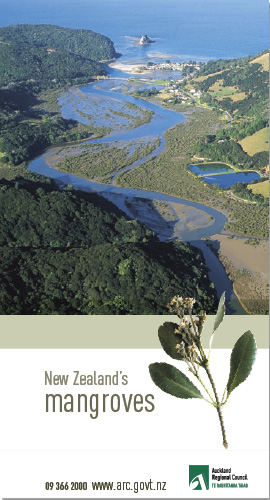Mangrove native for a mere nineteen million years

Waiwera’s Mangroves: Unlike the voluminous Mahurangi, rivers like the Waiwera regularly flush their sediment clear out to sea. (The island off the river mouth is Mahurangi.) image Auckland Regional Council
I find it difficult to understand just why I so adore mangroves.
I only came into close contact with them in my early teens, when my family moved to Waiwera from just south of the 38th parallel—about the southern limit of mangrove habitat.
My respect for them was first engendered during school holidays at my aunt’s house overlooking the mangroves of Portland Road, Auckland. Why my aunt and uncle saw them as worthy I have no idea, as neither was native to the area—my father’s family hailing from the deepest King Country and my uncle from Norfolk, England.
I suspect it simply reflected their utter reverence of the natural world. So mangroves, for me, were synonymous with childhood visits to the Auckland Museum and viewing the latest Disney wildlife epoch.
Some of my best friends loathe mangroves.
Regardless of any concern about proliferation, I wonder if many instinctively see them as unnatural interlopers that have no business occupying the marine estate.
The Auckland Regional Council’s new publication New Zealand’s Mangroves should greatly assist those who loathe them, and those who love them, equally.
(The booklet is a summary of the regional council’s technical paper: The New Zealand Mangrove: Review of the Current State of Knowledge Morrisey, D. et al, 2007).
Crucially, the booklet provides an essential reference for those contemplating the council’s Proposed Plan Change 4: Mangrove Management.
The proposed plan change will be very welcome news to those who are concerned about proliferation of mangroves in the Mahurangi. With provision, for example, for ‘the removal of mangrove seedlings by hand outside of the most environmentally sensitive areas’, those for whom the only good mangrove is a dead one, will barely be able to contain themselves. But before getting up your working party of like-minded souls, that plan change is:
- proposed only; and
- if made a Permitted Activity, would be subject to conditions.
The Auckland Regional Council now seeks submissions on the proposed plan change, by 28 November.
As Friends of the Mahurangi will be making submissions, members are urged to provide input. And, to make submissions in support of the resulting submission, or to make independent submissions.
Mangrove management is extremely important in the Mahurangi. But it is improbable that direct removal of mangroves on a large scale will be found to be desirable.
Wholesale removal of mangroves would result in muddier water. Every time the wind blew, wave action would re-suspend much more sediment than it does currently. Apart from the already stressed benthic communities, the oyster farms would be badly impacted—oysters need surprisingly clear water to feed without succumbing to malnutrition and mud blistering.
Long-term management will only be achieved by reducing sediment generation in the catchment.
My overall impression of the proposed plan change is that it is important and necessary. The limited or strategic removal of small areas of mangroves will always be necessary, for a variety of reasons including aquatic access—it is unnecessary to treat every individual mangrove as sacrosanct.
Conversely, knowing that some folk will require little encouragement to remove mangrove seedlings by hand, I shudder to think what many will chose to interpret as ‘outside of the most environmentally sensitive areas’!
Although submissions have been called for by 28 November, the plan change process, barring appeals, extends to mid-2008.
By then, we will all understand our indigenous mangrove better, and better understand the need to manage and protect it.
